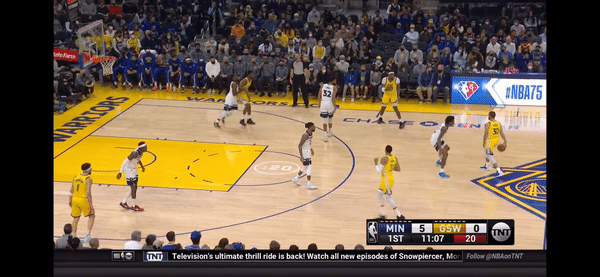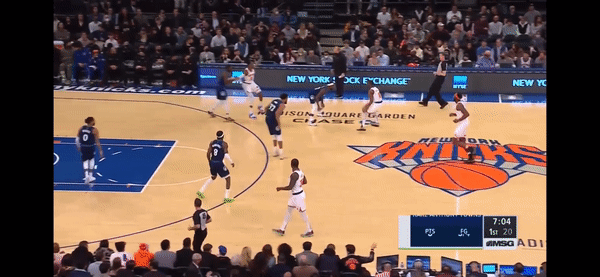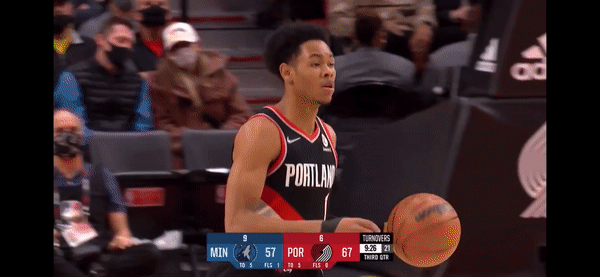This is the Wolves’ best defense since 2013-14!
So what gives?

Pack Defense
Less than a year into Head Coach Chris Finch’s tenure, and the Wolves are seemingly humming a new tune as a staunch defensive unit. Yes, you read that right. No need to squint or rub your eyes. Wolves + Defense. In the same sentence. And without the tired use of any and all synonyms of ‘substandard’. In what is immediately identifiable as a far cry from the scattershot defensive zone schemes of the past, Coach Finch’s rotation-heavy, man-to-man scheme has infused a newfound structure and energy to what’s long been a decrepit unit. But why the cause for surprise? Other than the fact that the team hasn’t been serviceable on that side of the ball for nearly a decade! The players are the same.
“The game has changed, but the players are the same!” - MacGruber
Hamstrung by the salary cap, the Wolves front office was dealt a limited hand with regards to player personnel changes this past offseason. So how do you explain the Wolves’ year-over-year ascent from 27th in Opponents’ Points per Possession (hereafter referenced as Pts/Poss.) to 12th?
All Hail Coach Finch. With the arrival of Coach Finch came a new defensive scheme, one that effectively neutralizes the high pick and roll concept that acts as every team’s primary freelance/set action nowadays. Steph Curry. Damian Lillard. James Harden. Trae Young. Kyrie Irving. You name it. It’s the most effective offensive action in basketball. Put the ball in the hands of a guy who can stretch the floor, penetrate and create off-the-dribble, give him some space, and the defense will scramble and break down.
So with that, let’s parse through some in-game clips to see just how the Wolves have learned to combat this measure. I’ll also guide you through some simple visualizations that illustrate how the team’s most used lineup ranks defensively against its peers. And we’ll take a look at the main bugaboo that has plagued the team all year - defensive rebounding. We’ll see if it’s trending in the right direction to justify whether or not a top-shelf trade for a big man like Myles Turner could benefit the team. So, let’s get started!
As of midseason, the Wolves lineup of Jaden McDaniels, D’angelo Russell, Anthony Edwards, Jarred Vanderbilt and Karl-Anthony Towns, having played 400+ possessions together, ranks as one of the top defensive units in the league. Now, how could they be doing this with Russell’s second-rate athleticism, Towns’ limited post-presence, and the limited weight of the team’s two long wings? This is where Coach Finch’s scheme comes into play.
The Wolves now deploy their two long, athletic forwards in McDaniels & Vanderbilt to guard the opposing team’s smaller guards in hopes to deter shots on the perimeter and dirty up the passing angles. When the opposing team calls for a high pick-and-roll with the center, Towns will blitz the ballhandler, arms up, to take away the potential three-point shot. And D’angelo Russell will rotate down to the paint from the weak-side to guard the roll man and find takeaways.
The data in the chart above backs up how strongly the team has adhered to that strategy. You can see that teams are shooting an extraordinarily poor three-point percentage against the Wolves best lineup as the guards are being pushed off the line, blitzed, and contested by 6’9 wings. Meanwhile, they are able to shoot effectively in the mid-range because that is where the offensive action is being funneled. And shots at the rim are also efficient in that there is no longer a big man post-presence waiting in the paint, as the low-man role has been taken over by a much smaller guard. Now, let’s take a look at this scheme in action.
Here, the Wolves are in their standard man defense. Off the bat, you might recognize that uniqueness to the Wolves’ scheme in that they use their long, athletic forwards to guard the opposing team’s guards. 6’9 Jaden McDaniels, #3, is on Steph Curry and 6’9 Jarred Vanderbilt, #8, is matched up with Klay Thompson. This snippet you see is a perfect example of what the team wants to accomplish on defense. The Warriors’ Kevon Looney sets an off-ball screen on Steph Curry at the top, and Jaden Mcdaniels and Karl-Anthony Towns converge on the ball, using their size and length to take away the shot and a clear passing lane into the paint. D’angelo Russell, #0, the ‘low-man’ here, rotates to meet the rolling Looney post-screen. And Vanderbilt guards the weak side. The team is able to take the shot away from Steph and Edwards comes away with the tip and leads the break.
Same thing here. Quick note - In prior years, the team always deployed Towns in drop coverage to watch the paint and the rolling big man. Now, you see that Towns follows the ballhandler to deter the shot until the primary defender can get over the screen. The scheme is executed perfectly here. Towns and Vanderbilt converge on the ball. Anthony Edwards rotates beautifully to meet the roller. And Russell and McDaniels position themselves on the weak side. They give up the basket, but its a long 2 from Wiggins - a shot you want the other team to take. Another note - because of the way this defense is oriented, the inefficient long 2 is now the shot that gets taken most often against the Wolves. The long wings and Towns are able to push 3 point shooters off the line and the low-man rotation often deters the immediate pass to the paint. Next up, you’ll see why.
In this clip here, the Knicks start this set play with a really nice action. It’s a set play for Mitch Robinson to get a dunk or get to the line. Really, it’s a no-doubter if the Knicks are able to execute better on the back-end. Randle starts it with a dribble-handoff. Then he flares around Mitch Robinson so Mitch can slip the screen for a quick shot in the paint. It’s a beautiful counter to the Wolves defense as the Knicks expect that the Wolves are going to converge on the ball. You can see the fake flex screen action going on at the baseline at the same time, with the intention of keeping D’angelo Russell’s back to the ball at the same time as the pass. However, that action is poorly done and mistimed, and Russell is able to turn and get the passing lane steal. Credit to Russell here for understanding his role on defense as the low-man and not getting consumed by that fake action.
Here’s another double screen set. This time, same side. The Wolves do a good job snuffing this one out. You can see Vanderbilt and Russell on the weak side discussing switching spots as the pick and roll action occurs. Makes it seem like they knew what was coming so they could put more size in the paint. Either way, KAT and Edwards converge on the ball. Mitch Robinson rolls and Vanderbilt is just a split second late as the low-man in rotating to meet Mitch at the basket. A good adherence to the scheme right here, and hopefully just a couple more reps away from proper execution.
Another good set play here from the Knicks. This time, the timing is executed perfectly by all five Knicks players. Screens set on both sides. Randle’s screen is noticeably tighter than Mitch’s, so as to keep Vanderbilt up over the arc, expecting the screen to go to the left. KAT is low, expecting Mitch to roll after Kemba goes left on the screen. Timing here is key as Kemba, instead, goes right, catching KAT off-guard with the crossover, leaving him in no-man’s land as Mitch rolls. At the same time, both corner shooters side-step up so the baseline defenders are caught in-between the roll and a potential kick-out 3. With the scheme in mind, what KAT should have done is stepp up on Kemba, taking away the midrange shot and lob opportunity. Russell the weak side defender would then drop to Mitch as the low-man and Vanderbilt would guard the weak side shooter on the rotation.
Here against the Trailblazers, Finch and the Wolves move away from their effective rotation-based man defense to a matchup zone. And to put it euphemistically, they really stink in this scheme. Like, the funk of all fucks kind of stink. They don’t bring it out all that often, only against heliocentric teams with ballhandlers that don’t give up the ball much and look primarily for their own shot. And it makes sense, with guys like Damian Lillard & CJ McCollum who can take advantage of switches and little gaps in space, you’d theoretically be better off trapping them and forcing them to pass as they look for that space to release a shot. At the onset of this clip, the Wolves are setting up in their zone. KAT tries to set in the paint and communicate with Edwards to hedge on the weak side and guard wing to baseline, and in doing so, gives up a wide-open corner three.
Here, we have a rare success story for the Timberwolves Zone Experience. You can see it’s a zone from the start based on how McDaniels and Vanderbilt set up after the initial screen. McDaniels stays on the left wing and Vanderbilt moves up on the ball. Anthony Edwards does a great job of positioning himself right outside the paint to intercept any possible action coming his way, and once Simons rejects the screen and drives to the rim, Edwards meets him head on. Shout out to Jarred Vanderbilt here as well for seeing Edwards drop to the paint and rotating out to the corner to pick up his man. The Wolves have openly struggled with this zone concept, and it would be an interesting study to compare the team’s man and zone unit deployments. Once the team hits the 100-possession benchmark for its zone defense, lets revisit and see just how much worse it actually is.
Now, the chart above compares the Wolves defensive percentile rankings compared with all other teams in five categories (effective field goal percentage, free throw rate, offensive rebound rate, pts. per possession, and turnover rate). A quick look at the graphic will tell you that the team is one of the better teams in the league in creating turnovers, forcing missed shots, and limiting the amount of points scored each possession down. But the most immediate, eye-catching image would be that of the offensive rebound rate. Offensive rebound rate is a stat that calculates the percentage of missed shots that a team allows the offensive team to rebound. So, it is very clear that the Wolves need some help on the defensive glass. Yes, a part of the issue can most likely be attributed to the scheme, in which shorter guards are closer to the basket upon shot release, with the longer wings and big men pressed up on the shooters near the three-point line. And the Wolves currently rank as one of the best offensive-rebounding teams in their own right, so maybe this a problem that needs immediate attention at the trade deadline?
If you look at the chart above, the Timberwolves defensive rebounding rate rank has increased every month this season, steadying at around middle of the pack for the past 3 months. So even though rumors of a big-man trade persist in Minnesota, with how well the team has been playing defensively in all other areas outside of defensive rebounding, maybe it would do well to sit status-quo and see how this young group continues to grow together. In any case, this current iteration of the team has shown the most promise on the backside of the ball since the Garnett era, and we should bask in the good basketball that we’ve been able to enjoy!
Defensive shooting accuracy and lineup data was gathered from https://cleaningtheglass.com/stats/ . Visualizations were created with Tableau and RStudio. R Markdown File below.
Thank you for your time and please feel free to reach out with any questions/thoughts!














